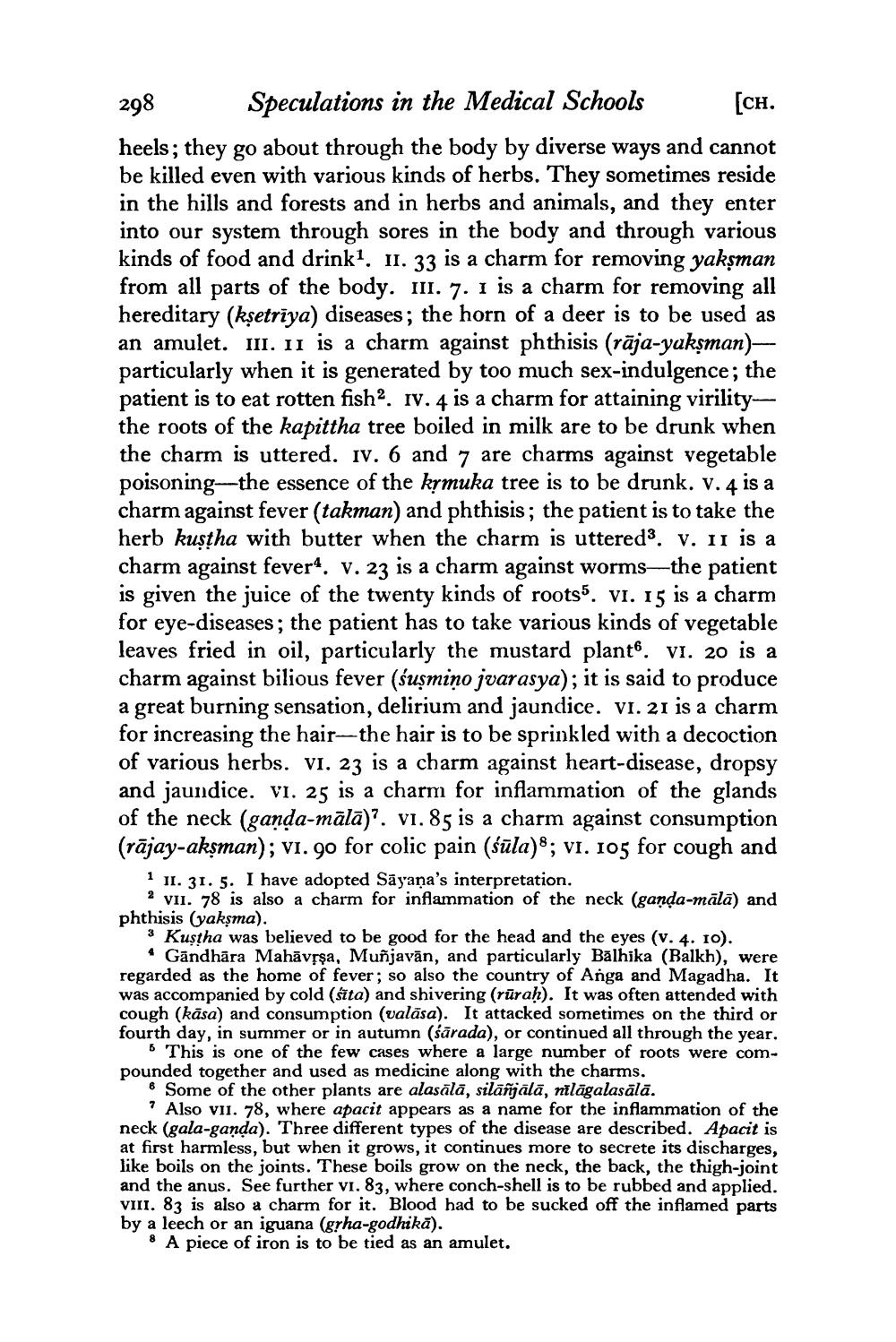________________
298 Speculations in the Medical Schools [CH. heels; they go about through the body by diverse ways and cannot be killed even with various kinds of herbs. They sometimes reside in the hills and forests and in herbs and animals, and they enter into our system through sores in the body and through various kinds of food and drink1. 11. 33 is a charm for removing yakşman from all parts of the body. III. 7. I is a charm for removing all hereditary (kşetriya) diseases; the horn of a deer is to be used as an amulet. III. 11 is a charm against phthisis (rāja-yakşman)particularly when it is generated by too much sex-indulgence; the patient is to eat rotten fish. iv.4 is a charm for attaining virilitythe roots of the kapittha tree boiled in milk are to be drunk when the charm is uttered. iv. 6 and 7 are charms against vegetable poisoning--the essence of the kṣmuka tree is to be drunk. v.4 is a charm against fever (takman) and phthisis; the patient is to take the herb kustha with butter when the charm is uttered. v. 11 is a charm against fever4. v. 23 is a charm against worms—the patient is given the juice of the twenty kinds of roots5. vi. 15 is a charm for eye-diseases; the patient has to take various kinds of vegetable leaves fried in oil, particularly the mustard plant. VI. 20 is a charm against bilious fever (suşmiņo jvarasya); it is said to produce a great burning sensation, delirium and jaundice. VI. 21 is a charm for increasing the hair-the hair is to be sprinkled with a decoction of various herbs. VI. 23 is a charm against heart disease, dropsy and jaundice. VI. 25 is a charm for inflammation of the glands of the neck (ganda-mālā)?. vi. 85 is a charm against consumption (rājay-aksman); vi. go for colic pain (śūla)8; VI. 105 for cough and
1 11. 31. 5. I have adopted Sāyaṇa's interpretation.
2 vii. 78 is also a charm for inflammation of the neck (ganda-mālā) and phthisis (yakşma).
3 Kustha was believed to be good for the head and the eyes (v. 4. 10).
• Gāndhāra Mahāvīşa, Muñjavān, and particularly Bălhika (Balkh), were regarded as the home of fever; so also the country of Anga and Magadha. It was accompanied by cold (sita) and shivering (rūrah). It was often attended with cough (kāsa) and consumption (valasa). It attacked sometimes on the third or fourth day, in summer or in autumn (śārada), or continued all through the year.
6 This is one of the few cases where a large number of roots were compounded together and used as medicine along with the charms.
6 Some of the other plants are alasālā, silāñjālā, nilāgalasālā.
? Also vii. 78, where apacit appears as a name for the inflammation of the neck (gala-ganda). Three different types of the disease are described. Apacit is at first harmless, but when it grows, it continues more to secrete its discharges, like boils on the joints. These boils grow on the neck, the back, the thigh-joint and the anus. See further vi. 83, where conch-shell is to be rubbed and applied. VIII. 83 is also a charm for it. Blood had to be sucked off the inflamed parts by a leech or an iguana (grha-godhikā).
8 A piece of iron is to be tied as an amulet.




